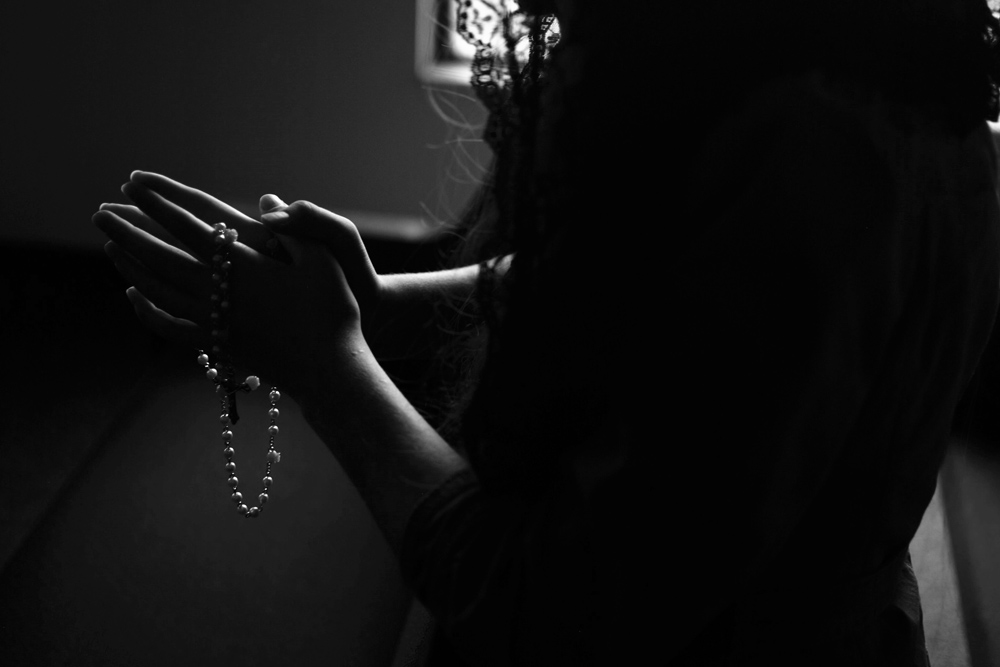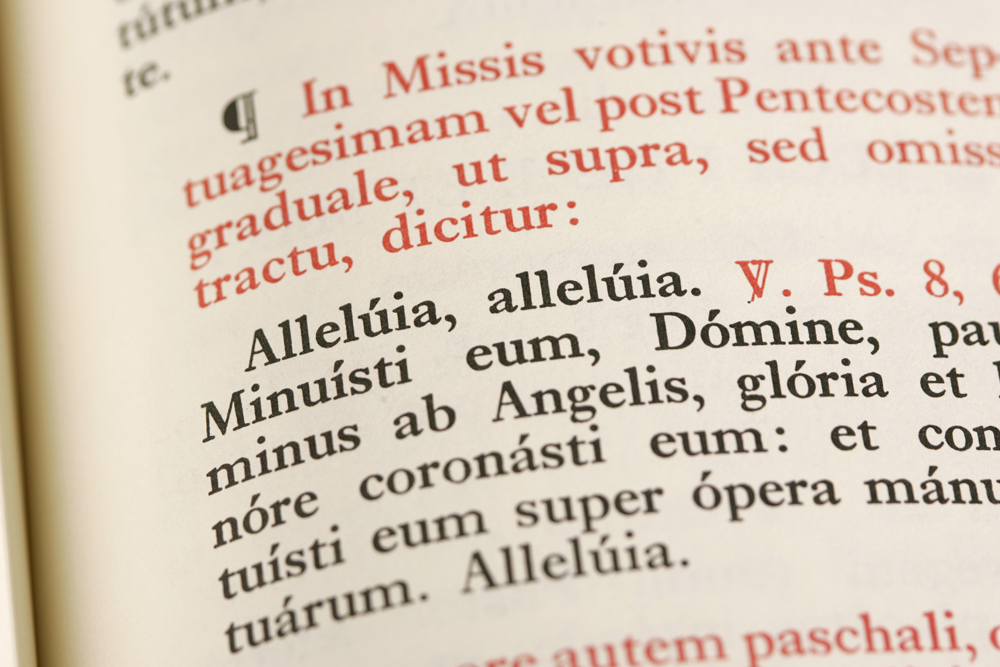
(Unsplash/twinsfisch)
One culture within the Catholic Church needing major reform is that surrounding the practice of the Latin Mass.
In a previous era, the Latin Mass was merely a uniform and standard way of celebrating the liturgy in the United States. In the wake of much needed reforms instituted by the Second Vatican Council, the Latin Mass has become a rallying point for change-resistant sects within the church. The ultra-conservatism practiced by these Latin Mass groups is radical and narrow-minded. They utilize the Latin Mass structure to wield control over believers — particularly women, who are reduced to a state of discriminatory subjugation in Latin rites. The stubbornly resistant, anti-modern practices of these Latin Mass adherents border on cultism.
The Latin Mass fosters clericalist structures in the church. The liturgy — spoken in an ancient language no longer in modern vernacular usage — places all power in the hands of the priest. The priest keeps his back turned to the people for most of the ceremony. Aside from making occasional responses, the congregation plays no active part in worship. All people inside the church are expected to kneel on cue at various points. The priest is at the center of the spectacle. He is separated from the people he is supposed to serve by an altar rail — a barrier that gives him privileges. To receive the Eucharist, people must kneel at his feet.
Instead of a unifying form of worship, the Latin Mass has become an instrument of oppression and a gathering point for Catholic fundamentalists.
Meanwhile, the Latin tradition oppresses women. Women are expected — indeed, in some cases commanded — to wear skirts instead of trousers, cover themselves with long clothing and wear veils over their heads. No such rules exist for the men. It is discrimination, and therefore the Latin Mass actively endorses sexism. Instead of a unifying form of worship, the Latin Mass has become an instrument of oppression and a gathering point for Catholic fundamentalists.
In most cases, it is useless to politely disagree with people in the Latin Mass sect. Their attitude creates blindness — not only to true faith, but to their own behavior. They treat others with pride and animosity, but their conscience fails to kick in because they are convinced their way is holy and other ways are not.
Anyone who may accuse me of not knowing what I'm talking about — a favorite indictment of the Latin Mass ideologues — would be wrong. My opinion is based on facts and personal experiences.
I grew up in a household of challenged but growing faith, which grew stronger over time. My parents were divorced. My mother was a fallen-away Catholic who hadn't been to church in over 30 years. In the branches of my family tree were relatives who might best be described as atheists, and others of a more traditional Christian type. My mother decided to return to the Catholic Church when I was young. From an early age, I believed in Christ and considered myself a Catholic — other relatives tried in vain to convert me to atheism while I was still in elementary school.
Maybe this sounds like the beginning of a happy story of faith and discovery. It was not. My family's journey into the Catholic Church was a long, tumultuous and unpleasant road punctuated by a series of awful mistreatments by Catholic clergy, religious, schools and parishioners. (It's a miracle that I'm still Catholic and became a Catholic journalist.)
The Latin Mass rears its veiled head in this unholy history at several points. The last Masses my mother remembered attending took place before the Second Vatican Council, so naturally she started going to Latin Masses when she returned to the church because they were familiar. The church was going to welcome us, she thought. The treatment we got was slightly shy of the Spanish Inquisition.
Needless to say, anything in the church looking remotely female was completely veiled. The people had the humor of a gallows crowd and the pastor, arrayed in lavish vestments, was more like a Renaissance baron. After over an hour spent every Sunday drowning in incense smoke and getting sneered at, we did not feel any closer to God.
"You should come to the Latin Mass instead and wear a veil. Women look the most beautiful in church when they are veiled," he tried to persuade.
Rules, also, were a strange issue. For example, the color red was forbidden to be worn in the church. A confessor there hit one of my family members with a "permanent daily penance"— a rosary every day, forever, to atone for an alleged life of iniquity. After some while of this torture, my mother spoke with a different priest about the unbearable situation. He advised her that genuine Catholic faith did not forbid wearing certain colors or allow priests to inflict a "lifetime penance" for sins. Immediately we stopped going to Mass at that parish.
But it wasn't the last time I would run into Latin Masses — or the Latin Mass sectarians, present today in many Catholic organizations.
After almost leaving the church as a teenager, I chose to stay Catholic by practicing my faith as a free agent — belonging to no parish, attending different churches for Sunday Mass. On one instance, a priest noticed I was showing up semi-regularly and approached me with a persuasive speech to convert me to the Latin Mass faction — disguising discrimination as encouragement. "You should come to the Latin Mass instead and wear a veil. Women look the most beautiful in church when they are veiled," he tried to persuade. "The long veils are the best kind — the really long ones, past the shoulders. I recommend that for you — you have such pretty red hair, but it would even look nicer if you wore a veil over it. I think the long kind would be best for you."
Most disturbing about this conversation was his effort to make repression sound positive. Of course it made no sense that my hair would somehow look better if people couldn't see it. Indignant, I asked him to explain why he thought I should consider covering my head.
"Because it's respectful," he replied solemnly.

Shown is a detail of text in Latin from a page of the 1962 Roman Missal. (CNS/Nancy Wiechec)
When asked why it was disrespectful to show the hair that God gave me — and why men in church did not have to cover their hair — he was not able to answer. He reacted badly because I challenged his authority. Anyway, I had no intention of listening. I knew I was free to take my belief in God elsewhere. I never returned to that church afterwards.
The priest's attitude towards veiling women is typical of Latin Mass cultists. They seem to believe that women look better in church when people can't see them. They try to sell the veil to girls as a symbol of feminine piety. They hold that covering up and hiding yourself is beautiful although such a practice is the very opposite of natural beauty.
Ultimately, it doesn't matter how pretty, lacy or colorful the veils may seem to potential wearers — the veils are meant to conceal female beauty and prevent people from noticing women. By promoting the veil, Latin Mass fundamentalists rob women of freedom, while trying to make it seem like a liberating choice. Their attitude is not much different from religious extremists in the Middle East and Asia.
Given such practices, it should come as no surprise that a contingent of men active within the sectarian Latin Mass environment have sexist worldviews. These types believe they are superior to women simply because they are male.
Advertisement
I cite two examples to support my view. One occasion that remains burned into my memory was when I attended Mass at a Catholic university. It was a busy Sunday and my schedule demanded I attend Mass at a particular time. I did not know it was a Latin Mass until I stumbled over the doorstep. The atmosphere was typically medieval. I was surprised to recognize some people there. One of them was a professor who was known to be a chauvinistic person. When I saw his wife, I was shocked — and suddenly realized the ugly extent of his prejudices. His wife was a mere ghost of a woman. She was covered from head to foot. Her dress was so long that it dragged on the floor. Even her entire neck and her hands were covered. She kept her head bowed and always walked behind her husband. She carried a rosary and looked physically weak — almost ill.
The professor, by contrast, looked swaggering and hearty. He strutted around and chatted with others in church as she followed him like a pale shadow. Seeing this, I believed I had witnessed a very dark side to the professor's spirituality. His religion was a mechanism of abusive control.
My second example concerns a younger Catholic age group — many of whom are apparently falling victim to the ultra-traditional Latin Mass ideology promoted in Catholic activity groups and on college campuses. A female acquaintance of mine, about my age, decided to brave the Catholic dating scene — a recipe for disaster, in my personal opinion. Among the stories I heard from her were of traditional Catholic males shopping for wives, asking her and other girls, "Are you willing to be veiled?" before agreeing to date them. These men did not want to associate with women whom they couldn't religiously dominate.
Men she met in this traditional Catholic peer group would interview girls about theology before deciding to spend time with them — they were arrogant and believed they were somehow morally superior to the women. Instead of standing up for her own dignity, she decided to cave into the pressure — go to traditional services and start wearing veils. I still don't understand why she wanted to associate with that group, or why she decided to give in to oppression.
It is very unfortunate that younger generations of Catholics seeking to deepen their faith are getting sucked into this vortex of toxic, traditional radicalism. I saw many young families at a Latin Mass recently when I was invited to attend a speaking engagement at a traditional church. I happened to arrive before Mass was quite over — having nowhere else to go before the event, and wishing to receive Communion, I decided to sit in on the Mass. Unsurprisingly I found myself surrounded by veiled women who entertained themselves in between kneeling bouts by casting disapproving glances at my leggings and earrings.
Looking around, I was astonished to see many college-aged men and women among the crowd. The priests seemed to be in their 30s. Clearly these people were too young to remember times before Vatican II. Yet something had drawn them here. Parental influence? Doubtful. It seemed to be a shared spirit of ultra-conservatism. I found it frightening to reflect on how the closed, Latin Mass mindset had managed to replicate itself over time and spread like a virus.
Unsurprisingly, while there I had another memorably bad experience. I asked to receive Communion in the hands. Most traditional-type priests I'd encountered in my lifetime would give me the Eucharist in the hands. Not this pastor. He literally made a scene at the altar and jerked the Eucharist away from me when I reached out to receive it — as if my hands would contaminate the very Jesus who, according to the Catholic faith, seeks Communion with my soul. I seriously considered walking out of the church at that point, but decided to receive the Eucharist instead since I wanted to pray. After Mass I gave the priests a piece of my mind.
I reminded him that, as a priest, he was supposed to be of service and value my feedback as a believer.
Clericalism defined the response I received. When I informed an assisting priest that the pastor had been very rude to me at the altar and asked that my views be relayed, he replied: "I won't throw our pastor under the bus. He's the pastor. I refuse to tell him to correct his behavior," the priest said.
I reminded him that, as a priest, he was supposed to be of service and value my feedback as a believer. The priest took a step back and looked at me in astonishment, as if the notion of service had never occurred to him. "Very well. I'll tell the pastor what you said," he said condescendingly. "But I don't think he did anything wrong."
His attitude was a trademark example of the culture within the Catholic Church that encourages abuse. His first reaction was to default to absolute loyalty to his pastor, then dismiss my views. When pressed further, he flat-out denied all wrongdoing. To clericalists, complainers are always the problem — not those who belong to the herd, and certainly not clergy.
With feudalistic rigidity, the priest argued in defense of his pastor against the traditions of the "novus ordo"—a derogatory term used by Latin Mass cultists to denote regular English-language Masses. He said the Masses I regularly attended were invented "only 40 years ago" — as if that devalued them somehow —and insisted they were only "allowed to exist, but not standardly recommended." He claimed the church only allowed Communion in the hands "in extreme cases." Of course, I know this is not true. He capped his radical fundamentalist arguments by saying the Latin Mass is a solemn rite equal to Byzantine and Coptic rites and that rules cannot be changed for anyone. He accused me of being "rude" by expecting them "to change their rites."
I feel it necessary to point out — lest readers be confused by his illogicality — that the Byzantine and Coptic rites originate in the traditions of distinct Catholic churches in foreign countries. The Latin Mass, by contrast, is merely an extinct model of tradition practiced in the United States and other countries, and was never a separate church nor imported from a foreign country. Therefore the Latin Mass can be compared to Coptic and Byzantine churches as much as apples can be compared to oranges. No ancient Romans or native Latin speakers will be disenfranchised by changes made to the Latin Mass — just hardliners unable to let go of their particular ideology.
What I gained from this experience was a deeper recognition of how the Latin Mass foments the clericalist culture within the Catholic Church that Pope Francis is actively working to change.
In his homily earlier last month, Pope Francis warned Catholics against hypocrisy. He described hypocrisy as "appearing one way, but acting in another," and said that a hypocritical attitude "always kills."
Jesus did not tolerate hypocrisy, according to Pope Francis, but enjoyed unmasking it. "A Christian who does not know how to accuse himself is not a good Christian," the pope said.
The intolerant atmosphere of the Latin Mass stands in stark contrast to Pope Francis's description of what the Catholic Church is supposed to be. "The church is not a fortress, but a tent capable of expanding and offering access to everyone," said Pope Francis. "The church is 'going out' or it is not church, either it is walking, always widening its room so that all may enter or else it is not church."
Compassion defines true Catholicism. Radical traditionalists who cling to the pomp, ceremony and narrow-minded rituals of outdated Latin practices would do well to follow the advice of Jesus in the Gospel of Matthew, Chapter 9: "Go and learn the meaning of the words, 'I desire mercy, not sacrifice.' "
[Zita Ballinger Fletcher has reported extensively on Germany's Catholic Church for Catholic News Service.]








